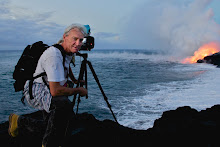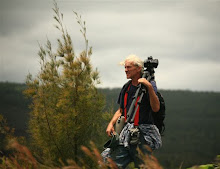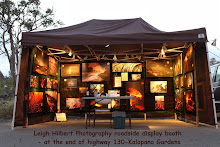 The photo above, taken this morning and contributed to the blog by Ron Boyle, shows pahoehoe advancing across a small blacksand beach on the shoreline directly south of the old county viewing area. Lava continues building new benches for a quarter-mile section of this coastline.
The photo above, taken this morning and contributed to the blog by Ron Boyle, shows pahoehoe advancing across a small blacksand beach on the shoreline directly south of the old county viewing area. Lava continues building new benches for a quarter-mile section of this coastline.Below are two photos I took May 2, 2010 of that original Waikupanaha County viewing area with the new entry plume beyond. For those of you that were out there when that lava ocean entry was active, you may notice how all the land in front and to the sides of the viewing area is now level with new lava. You can see the marked walking path tape is still there too.

 The same little security hale is still intact
The same little security hale is still intact USGS deformation – inflation/deflation graphs are charting inflation now. This could translate into a more aggressive action down the Pulama Pali, surface flows and coastal entries. It is also causing the Halema’uma’u crater to glow very brightly after dark—check it out!
----------------------------------------------------------------------------------
Below is a reposting of the general overview of conditions on the coast since little has changed in three days:
Halema’uma’u Crater still glowing brightly ~ Lava flows hot from mountain to sea

US Geological Service (USGS) at Hawaii Volcanoes National Park Observatory (HVO) has posted this excellent aerial photo over crater (above) on their images page. On that page they also have photos and captions about the Pu`u O`o crater cam they lost when a piece of the crater sloughed off a few days ago.
 (Click on it for a larger view size in a new window)
(Click on it for a larger view size in a new window)The aerial photo is from the April 28th, 2010 USGS image site, and surface lava has advanced further in many areas since, as indicated on my drawings and notes.
 Halema’uma’u crater as seen after dark from the balcony of the Jaggar Museum
Halema’uma’u crater as seen after dark from the balcony of the Jaggar MuseumActive lava viewing prospects:
1) The Halema’uma’u crater has been degassing sulfur dioxide fumes by day and glowing strongly at times after dark from lava deep within the craters pit vent. Great views are from the Jaggar Museum within the Hawaii Volcanoes National Park, and the park is open to the public 24 hours a day.
2) Coastal viewing:
Highway 130 at Kalapana Gardens area -- Between the hours of 2:00 PM and 8:00 PM - park and walk one mile to the end of newly lava covered (May 5th) road; viewing is allowed until about 9:00 PM. Along the walk out and back the steam plume from the distant ocean entry lava can be seen and after dark it glows orange-red; long lines of degassing lava fumes coming down the hillsides by day –distant red lava orbs lined-up by night; at roads end the still-warm lava on the road can be felt and is still radiating hotter close by but beyond public access; occasional yellow flare-ups are witnessed in the distance as lava torches trees and vegetation further into the active flow field. Offered at the parking area only: security personnel, vendors, water and port-o-potties available; at roads end there are barricades, port-o-potties and security personnel.
USGS lava flow map gives a good indication of the active lava zones:


~~~~~~~~~~~~~~~~~~~~~~~~~~~~~~~~~~~~~~~~~~~~~~~~~~~~~~~~~~~~~~~~
Further information, links and warnings:
Active pahoehoe breakouts continue along with swelling of the hot flow fields at many locations of the April-May surface flow. The coastal entry points are still emptying a lot of lava into the sea as new deltas area being rapidly built. The entire length of the ocean entry and all land adjacent to it inland is quickly becoming unstable and should be kept well aware of from now on:
HAZARD ALERT: The lava delta and adjacent areas both inland and out to sea are some of the most hazardous areas on the flow field. Frequent delta/bench collapses give little warning, can produce hot rock falls out to 400 m (quarter mile) inland and in the adjacent ocean, and can produce large local waves and scalding water. The steam plume produced by lava entering the ocean contains fine lava fragments and an assortment of acid droplets that can be harmful to your health. The rapidly changing conditions near the ocean entry have been responsible for many injuries and a few deaths.
Below is the timeline links to my posts for this April-May flow:
You can watch the May 5th feature Hawaii-News-Now story of the lava coming onto the end of highway 130 by clicking this link here
Click on this link for a complete blog summary of this entire April, 2010 surface flow of lava; from mountain to sea: (scroll to the bottom and read each post running up for a chronological timeline)
And my most recent days postings for May, 2010
I will keep this as my main posting update layout in the coming days, adding new headings and images as lava events warrant.










No comments:
Post a Comment